#CancerComplications
Explore tagged Tumblr posts
Text
youtube
#AML139#TherapyRelatedAML#EarlyOnsetLeukemia#HodgkinLymphoma#SecondaryCancer#ChemoInducedLeukemia#RadiationTherapy#CancerTreatment#LeukemiaRisk#AMLPrognosis#Oncology#Hematology#CancerComplications#LeukemiaTreatment#BoneMarrowTransplant#PatientCare#CancerResearch#MyeloidLeukemia#CancerSurvivor#LeukemiaAwareness#Youtube
0 notes
Text
cancer and what is causes,symptoms,treatment and type of cancer
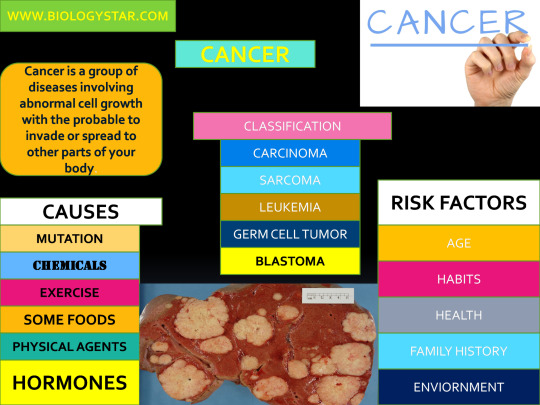
Cancer Overview
Cancer is a group of diseases involving abnormal cell growth with the probable to invade or spread to other parts of your body. These comparisons with benign tumors, which do not spread to other parts of the body. Practical signs and symptoms add a lump, unusual bleeding, prolonged cough, unexplained fat loss and a transformation in bowel motions. these symptoms may appear in cancer, but some other diseases also show some of these symptoms. Above 100 types of cancers impact humans. Tobacco use is the reason behind about 22% of malignancy deaths. Another 10% is because of obesity, poor diet, insufficient physical activity or increased drinking of alcohol. Other elements include certain infections, contact with ionizing radiation and environmental pollutants. In the developing world, 15% of cancers are because of infections such as for example Helicobacter pylori, hepatitis B, hepatitis C, human papillomavirus infections, Epstein-Barr virus, and individual immunodeficiency virus (HIV). These elements take action, at least partly, by changing the genes of a cell. Typically, many genetic improvements are required before cancers develop. Approximately 5-10% of cancers are because of inherited genetic defects from someone's parents. Cancer could be detected by certain signs or symptoms or screening tests. It really is then typically additional investigated by medical imaging and verified by biopsy. Many cancers can be avoided by not smoking, maintaining a wholesome weight, not drinking an excessive amount of alcohol, eating a good amount of vegetables, fruits, and whole grains, vaccination against certain infectious diseases, not eating an excessive amount of processed and red meat and avoiding an excessive amount of sunlight exposure. Early on detection through screening pays to for cervical and colorectal cancer. The benefits associated with screening in breast cancers are controversial. Cancer is normally treated with some combo of radiation therapy, medical procedures, chemotherapy, and targeted therapy. Soreness and symptom operations are a crucial part of care. Palliative treatment is particularly important in people with advanced disease. The chance of survival will depend on the kind of cancer and level of disease at the beginning of treatment. In children under 15 at diagnosis, the five-year survival price in the developed globe is normally 80%. For a tumor in the United States, the common five-year survival rate is 66%. In 2015, about 90.5 million people got cancer. About 14.1 million new cases occur a year (excluding skin cancer apart from melanoma). The most common types of cancer in men are lung cancer, prostate cancers, colorectal cancer and stomach cancers. In females, the most frequent types are breast cancers, colorectal cancer, lung cancer, and cervical cancer. If epidermis cancer apart from melanoma was contained in total new cancer situations each year, it would take into account around 40% of conditions. In children, severe lymphoblastic leukemia and human brain tumors are most prevalent, except in Africa where non-Hodgkin lymphoma occurs more regularly. The chance of cancer increases drastically with age, and several cancers occur additionally in developed countries. Rates are increasing as more persons live to a vintage age and as changes in lifestyle occur in the developing environment. The financial costs of cancer were estimated at $1.16 trillion USD annually as of 2010.
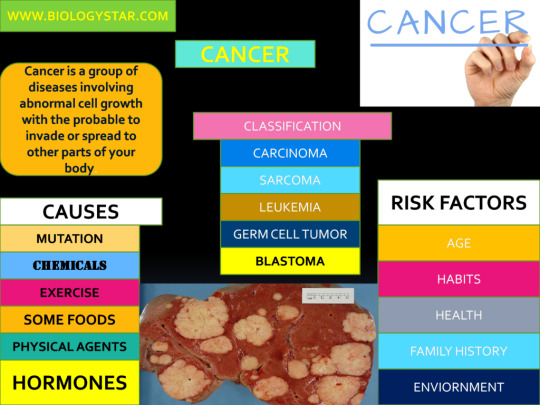
OVERVIEW
Cancer Causes
Cancer is a complex band of conditions with many possible causes. In this section, you can find out more on the regarded and possible causes of cancer, along with general information regarding carcinogens and how genetics are likely involved in cancer. Cancer is caused by adjustments (mutations) to the DNA within cells. The DNA in the cell can be packaged into a sizable number of individual genes, each of which contains a set of guidance telling the cell what capabilities to execute, as well as how to grow and divide. Errors in the recommendations can cause the cell to stop its normal function and may allow a cell to be cancerous. What do gene mutations do? A gene mutation can instruct a wholesome cell to: Allow quick growth. A gene mutation can notify a cell to expand and divide quicker. This creates many latest cells that all have that same mutation. Fail to stop uncontrolled cell development. Normal cells know when to avoid growing in order that you have the ideal number of each kind of cell. Cancers cells lose the handles (tumor suppressor genes) that inform them when to stop growing. A mutation in a tumor suppressor gene allows cancer cells to keep growing and accumulating. Make mistakes when fixing DNA errors. DNA service genes search for errors in a cell's DNA and make corrections. A mutation in a DNA service gene may mean that different errors aren't corrected, leading cells to become cancerous. These mutations are the most frequent ones within cancer. But a great many other gene mutations can donate to causing cancer. What causes gene mutations? Gene mutations may occur for many reasons, for instance: Gene mutations you're born with. You may well be born with a genetic mutation that you inherited from your own parents. This sort of mutation accounts for a small percentage of cancers. Gene mutations that occur after birth. Most gene mutations appear after you're born and aren't inherited. Several forces could cause gene mutations, such as for example smoking, radiation, viruses, cancer-causing chemicals (carcinogens), obesity, hormones, long-term inflammation, and too little exercise. Gene mutations occur frequently during regular cell growth. However, cells include a mechanism that recognizes whenever a mistake occurs and maintenance the mistake. Occasionally, a mistake is missed. This could result in a cell to become cancerous. How do gene mutations interact with each other? The gene mutations you're born with and those that you acquire during your life work together to cause cancer. For instance, if you have inherited a genetic mutation that predisposes you to cancer, that doesn't mean you're sure to get cancer. Rather, you may need a number of other gene mutations to reason cancer tumor. Your inherited gene mutation will make you much more likely than other people to build up tumor when exposed to a certain cancer-causing substance. It's not clear how many mutations must accumulate for cancer to form. It's likely that varies among cancer types.
Chemicals which cause cancer
Exposure to particular substances has been linked to specific types of cancer. These chemicals are called carcinogens. Tobacco smoke, for example, causes 90% of lung tumor. It also causes tumor in the larynx, head, neck, belly, bladder, kidney, esophagus and pancreas. Tobacco smoke contains over fifty known carcinogens, incorporating nitrosamines and polycyclic aromatic hydrocarbons. Tobacco is accountable for about one in five cancers deaths worldwide and about one in three found in the developed world. Lung cancer death rates in the USA have mirrored smoking habits, with increases in smoking accompanied by dramatic increases in lung cancer death costs and, recently, decreases in smoking prices since the 1950s followed by reduces in lung cancer death rates in men since 1990. In Western European countries, 10% of cancers in males and 3% of cancers in females are attributed to alcohol exposure, especially liver and digestive system cancers. Cancer from work-related chemical exposures could cause between 2 and 20% of cases, triggering at least 200,000 deaths. Cancers such as lung cancer and mesothelioma can come from inhaling tobacco smoke or asbestos fibers, or leukemia from contact with benzene.
Exercise
Diet plan, physical inactivity, and obesity happen to be linked to up to 30-35% of cancer deaths. In America, excess body weight is associated with the development of several types of malignancy and is one factor in 14-20% of cancers deaths. A UK research including data on over 5 million persons showed higher human body mass index to be linked to at least 10 types of tumor and responsible for around 12,000 situations each year in that region. Physical inactivity is thought to contribute to cancer risk, not merely through its effect on body weight but also through unwanted effects on the disease fighting capability and endocrine system. Over fifty percent of the result from a diet is due to overnutrition (eating an excessive amount of), rather than from eating too little vegetables or other healthful foods.
Some specific foods are associated with specific cancers
. A high-salt diet is associated with gastric cancer. Aflatoxin B1, a good frequent food contaminant, triggers liver cancer tumor. Betel nut chewing could cause oral cancer. National differences in dietary practices may partly make clear differences in tumor incidence. For example, gastric cancer is more common in Japan because of its high-salt diet while cancer of the colon is more prevalent in the United States. Immigrant cancer tumor profiles develop mirror that of their new country, often within one generation.
INFECTION
Worldwide approximately 18% of cancers deaths are linked to infectious diseases. This proportion ranges from a higher of 25% in Africa to less than 10% in the developed world. Infections are the usual infectious brokers that cause cancer but cancer bacteria and parasites could also play a role. Oncoviruses (viruses that may cause cancer) include human being papillomavirus (cervical cancer tumor), Epstein-Barr virus (B-cell lymphoproliferative disease and nasopharyngeal carcinoma), Kaposi's sarcoma herpesvirus (Kaposi's sarcoma and major effusion lymphomas), hepatitis B and hepatitis C infections (hepatocellular carcinoma) and people T-cell leukemia virus-1 (T-cell leukemias). Infection may also increase the risk of cancer, as observed in Helicobacter pylori-induced gastric carcinoma. Parasitic infections associated with cancer involve Schistosoma haematobium (squamous cell carcinoma of the bladder) and the liver flukes, Opisthorchis viverrini and Clonorchis sinensis (cholangiocarcinoma).
RADIATION
Up to 10% of invasive cancers are related to radiation publicity, including both ionizing radiation and non-ionizing ultraviolet radiation. On top of that, the majority of non-invasive cancers are non-melanoma epidermis cancers caused by non-ionizing ultraviolet radiation, mostly from natural light. Sources of ionizing radiation involve medical imaging and radon gas. Ionizing radiation is not an especially strong mutagen. Residential contact with radon gas, for instance, has similar cancer hazards as passive smoking. Radiation is certainly a more potent way to obtain cancer when coupled with other cancer-causing agents, such as radon plus tobacco smoke. Radiation could cause cancer in most areas of the body, in all animals and at any years. Children and adolescents are doubly likely to develop radiation-induced leukemia as men and women; radiation exposure before birth has ten instances the effect. Medical make use of ionizing radiation is a small but growing way to obtain radiation-induced cancers. Ionizing radiation enables you to treat other cancers, but this might, in some cases, induce another form of cancer. It is also used in some varieties of medical imaging. Prolonged exposure to ultraviolet radiation from sunlight can bring about melanoma and different skin malignancies. Clear data establishes ultraviolet radiation, specifically the non-ionizing channel wave UVB, as the reason for most non-melanoma pores and skin cancers, which will be the most common kinds of cancer in the world. Non-ionizing radio rate of recurrence radiation from mobile phones, energy transmission, and other similar sources have been referred to as a practical carcinogen by the Globe Health Organization's International Organization for Research on Cancer. Even so, studies have not really found a consistent link between cell phone radiation and cancer risk.
Physical agents
Some substances cause cancer generally through their physical, rather than chemical, effects. A prominent exemplary case of this is prolonged exposure to asbestos, obviously occurring mineral fibers that are a major cause of mesothelioma (cancer tumor of the serous membrane) generally the serous membrane encircling the lungs. Other chemicals in this category, including both naturally occurring and synthetic asbestos-like fibers, such as for example wollastonite, attapulgite, cup wool, and rock wool, are believed to have similar effects. Non-fibrous particulate materials that reason cancer involve powdered metallic cobalt and nickel and crystalline silica (quartz, cristobalite, and tridymite). Generally, physical carcinogens must get inside the body (such as for example through inhalation) and need years of contact with produce cancer. Physical trauma leading to cancer is relatively rare. Claims that breaking bones led to bone cancer, for instance, have not shown. Similarly, physical trauma is not accepted just as a cause for cervical cancer, breast cancer or brain cancer. One accepted source is frequent, long-term application of hot things to the body. It's possible that repeated burns on a single part of the human body, such as for example those made by kanger and Kairo heaters (charcoal hand warmers), may produce epidermis cancer, particularly if carcinogenic chemicals are also present. Frequent consumption of scalding sizzling hot tea may produce esophageal cancers. Generally, it is believed that cancers arise, or a pre-existing cancer is encouraged, through the process of healing, instead of directly by the trauma. However, repeated injuries to the same tissues might promote increased cell proliferation, which could then increase the probability of a cancerous mutation. Inflammation can donate to the proliferation, survival, angiogenesis, and migration of cancer tumor cells by influencing the tumor microenvironment. Oncogenes build up an inflammatory pro-tumorigenic microenvironment.
Hormones
Some hormones are likely involved in the development of cancers by promoting cell proliferation. Insulin-like growth factors and their binding proteins take up a key role in tumor cell proliferation, differentiation, and apoptosis, suggesting practical involvement in carcinogenesis. Hormones are important agents found in sex-related cancers, such as for example cancer of the breasts, endometrium, prostate, ovary, and testis and in addition to thyroid cancers and bone cancer. For instance, the daughters of women who have breast cancer have considerably higher degrees of estrogen and progesterone compared to the daughters of females without breast cancer. These larger hormone levels may describe their higher threat of breast cancer, also in the lack of a breast-cancer gene. In the same way, males of African ancestry have substantially higher levels of testosterone than guys of European ancestry and have a correspondingly more impressive range of prostate cancer. Males of Asian ancestry, with the lowest degrees of testosterone-activating androstanediol glucuronide, possess the cheapest levels of prostate cancer. Other elements are relevant: obese people have higher degrees of some hormones associated with cancer and an increased rate of those cancers. Women of all ages who take hormone replacement remedy have a higher risk of developing cancers connected with those hormones. Alternatively, people who exercise a lot more than average have lower levels of these hormones and lower risk of cancer. Osteosarcoma could be promoted by hgh. Some treatments and prevention techniques leverage this reason by artificially reducing hormone amounts and therefore discouraging hormone-sensitive cancers.
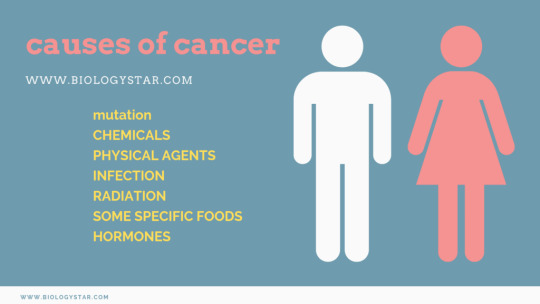
causes of cancer
Autoimmune diseases
There is an association around celiac disease and an increased risk of all cancers. People with the untreated celiac disease have a higher risk, but this risk decreases as time passes after diagnosis and strict treatment, probably as a result of the adoption of a gluten-no cost diet, which seems to get a protective role against the expansion of malignancy in persons with celiac disease. Even so, the delay in diagnosis and initiation of a gluten-free diet plan seems to increase the threat of malignancies. Costs of gastrointestinal cancers are heightened in people with Crohn's disease and ulcerative colitis, due to chronic inflammation. As well, immunomodulators and biologic brokers used to take care of these diseases may promote growing extra-intestinal malignancies.
Classification of cancer
Cancers are actually classified by the sort of cell that the tumor cells resemble and is therefore presumed to come to be the foundation of the tumor. These kinds include: Carcinoma: Cancers derived from epithelial cells. This group contains many of the most prevalent cancers and include nearly those in the breast, prostate, lung, pancreas, and colon. Sarcoma: Cancers arising from connective tissue (we.e. bone, cartilage, excess fat, nerve), each which develops from cells while it began with mesenchymal cells beyond your bone marrow. Lymphoma and leukemia: These two classes arise from hematopoietic (blood-forming) cells that keep the marrow and have a tendency to mature in the lymph nodes and blood, respectively. Germ cell tumor: Cancers produced from pluripotent cells, most often presenting in the testicle or perhaps the ovary (seminoma and dysgerminoma, respectively). Blastoma: Cancers produced from immature "precursor" cells or perhaps embryonic tissue. Cancers are usually named using -carcinoma, -sarcoma or -blastoma as a suffix, with the Latin or perhaps Greek phrase for the organ or cells of origin as the root. For instance, cancers of the liver parenchyma arising from malignant epithelial cells are called hepatocarcinoma, while a malignancy due to primitive liver precursor cells is named a hepatoblastoma and cancer arising from fat cells is named a liposarcoma. For some common cancers, the English organ brand is used. For example, the most frequent type of breast tumor is named ductal carcinoma of the breasts. Here, the adjective ductal identifies the appearance of cancer beneath the microscope, which suggests that it has started in the milk ducts. Benign tumors (that are not cancers) are actually named using -oma as a suffix with the organ name as the root. For instance, a benign tumor of steady muscle cells has named a leiomyoma (the common name of this frequently occurring benign tumor in the uterus is certainly fibroid). Confusingly, some types of cancer utilize the -noma suffix, illustrations including melanoma and seminoma. Some types of cancers are named for the size and form of the cells in a microscope, such as for example giant cell carcinoma, spindle cell carcinoma, and small-cell carcinoma.
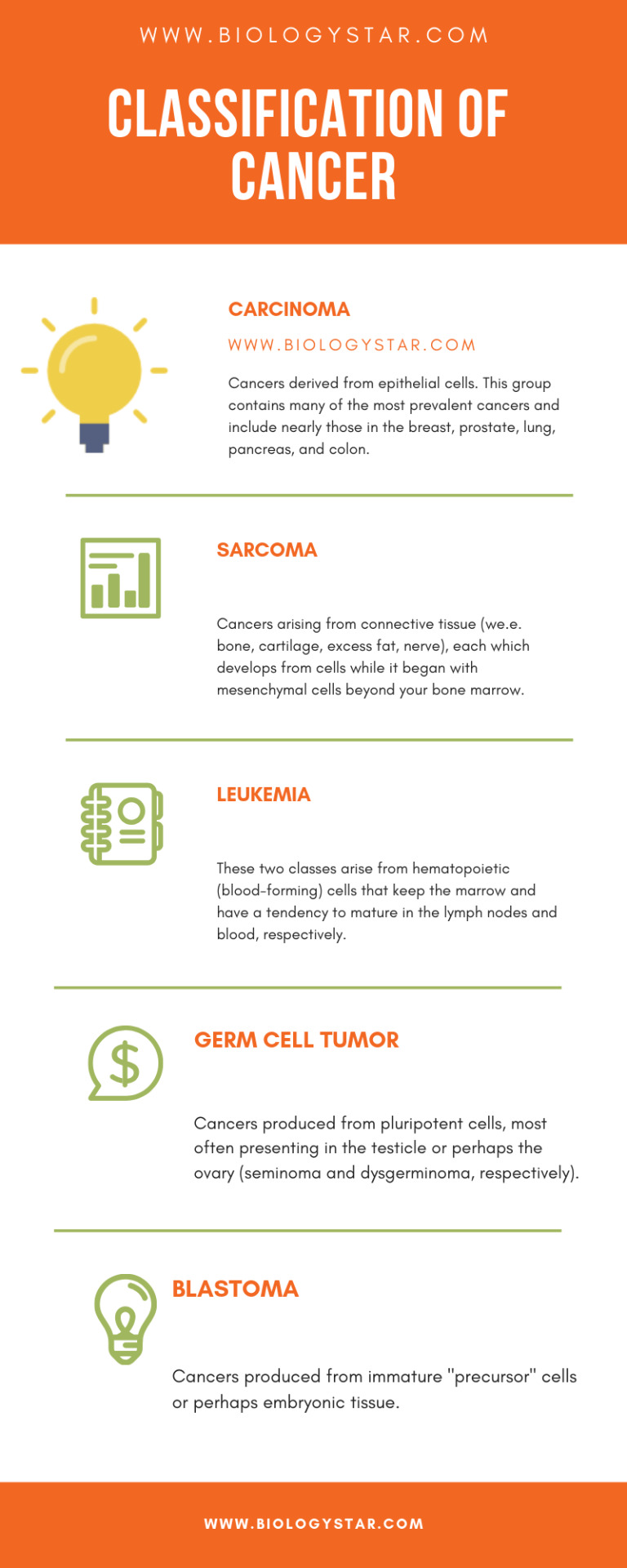
CLASSIFICATION OF CANCER
Risk factors
While doctors have a good idea of what may boost your risk of cancer, nearly all cancers occur in persons who don't have any known risk factors. Elements known to increase your risk of cancer include: Your age Cancer can take decades to build up. That's why most people identified as having cancer are 65 or older. While it's more prevalent in older adults, malignancy isn't exclusively an adult disease - cancer can be diagnosed at any age. Your habits Certain lifestyle choices are known to increase your threat of cancer. Smoking, drinking multiple alcoholic drinks a working day (for women of most ages and men over the age of age group 65) or two beverages a day (for men get older 65 and younger), excessive contact with sunlight or frequent blistering sunburns, obesity, and having unprotected sex can contribute to cancer. You can change these habits to lessen your risk of cancer - through some habits are simpler to change than others. Your family history Only a small portion of cancers are because of an inherited condition. If a tumor is common in your loved ones, it is possible that mutations are staying passed from one generation to another. You might be a prospect for genetic assessment to see whether you have inherited mutations that may increase your threat of certain cancers. Understand that having an inherited genetic mutation doesn't invariably mean you'll get cancer. Your health conditions Some chronic well-being conditions, such as for example ulcerative colitis, can markedly boost your threat of developing certain cancers. Speak to your doctor about your risk. Your environment The environment around you might contain harmful chemicals that can increase your risk of cancer. Even when you don't smoke, you may inhale secondhand smoke if you go where people are smoking or if you live with somebody who smokes. Chemicals in your home or workplace, such as for example asbestos and benzene, also are associated with an increased risk of cancer.
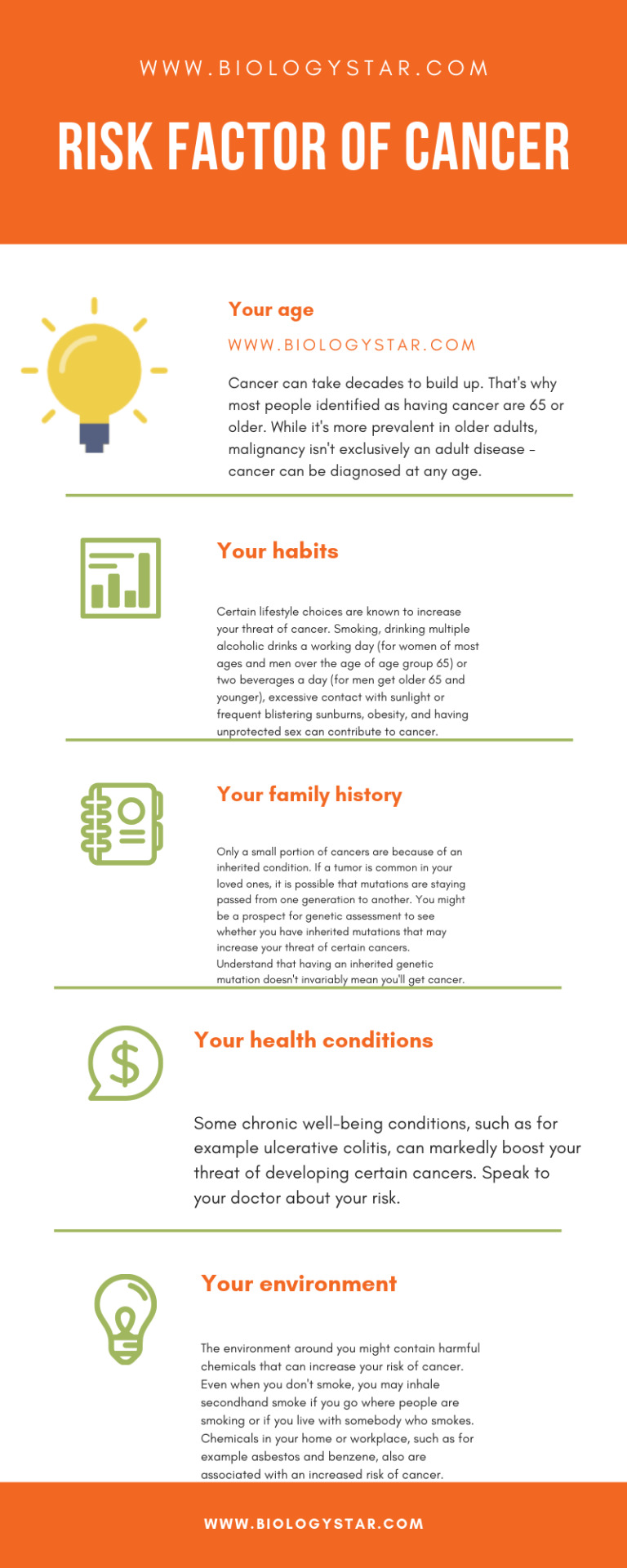
RISK FACTORS OF CANCER
Cancer Symptoms
Cancer often does not have any specific symptoms, so that it is important that persons limit their risk elements and undergo appropriate cancer screening. Most cancer screening is specific to particular age groups as well as your primary health care doctor will know very well what screening to perform depending on your age. People who have risk factors for cancer (for instance, smokers, heavy alcohol use, large sun exposure, genetics) ought to be acutely aware of potential cancer symptoms and become evaluated by a physician if any develop. The simplest way to fight cancers is normally by avoidance (eliminating or decreasing risk factors) and early detection. Consequently, individuals have to know which symptoms might indicate cancer. People shouldn't ignore a warning symptom that may lead to early on diagnosis and perhaps to a cure. A persistent cough or blood-tinged saliva. These symptoms usually represent straightforward infections such as for example bronchitis or sinusitis. A person with a nagging cough that lasts more than a month or with bloodstream in the mucus that's coughed up should see a medical expert. A change in bowel habits Most changes in bowel practices are related to your daily diet and fluid intake. Doctors sometimes find pencil-thin stools with cancer of the colon. Sometimes, cancer exhibits continuous diarrhea. Some people with cancer feel like they have to have bowel movements but still feel that way after they have had a bowel movement. If these abnormal bowel complaints last lots of days, they require evaluation. A substantial change in bowel patterns that cannot be easily explained by dietary adjustments needs to be evaluated. Blood in the stool A healthcare provider always should investigate blood in your stool. Hemorrhoids frequently cause anal bleeding, but because hemorrhoids are so general, they may exist with cancer. Therefore, even when you have hemorrhoids, you ought to have a doctor test your entire intestinal tract once you have blood in your bowel movements. With some individuals, X-ray studies may be plenty of to clarify a diagnosis. Colonoscopy is normally recommended. Routine colonoscopy, even without symptoms, is preferred once you happen to be 50 years old. Sometimes when the foundation of bleeding is totally clear (for instance, recurrent ulcers), these studies might not be needed. Unexplained anemia (low blood count) Anemia is a condition where people have less than the expected quantity of red blood cells in their blood. Anemia should be investigated. There are many sorts of anemia, but the loss of blood almost always causes iron insufficiency anemia. Unless there is an obvious resource of the ongoing loss of blood, this anemia must be explained. Many cancers can cause anemia, but bowel cancers mostly cause iron insufficiency anemia. Evaluation will include endoscopy or X-ray analyses of your top and lower intestinal tracts. Breast lump or breast discharge Most breasts lumps are noncancerous tumors such as fibroadenomas or cysts. But all breasts lumps have to be thoroughly investigated. A negative mammogram result isn't usually sufficient to evaluate a breast lump. Your doctor needs to determine the appropriate X-ray study which might involve an MRI or an ultrasound of the breast. Discharge from a breast is common, however, many forms of discharge may be signs of malignancy. If a discharge is usually bloody or from only 1 nipple, further evaluation is preferred. Women should conduct monthly breast self-examinations. Lumps in the testicles. Most men (90%) with cancer of the testicle possess a painless or uncomfortable lump on a testicle. Some men have an enlarged testicle. Other conditions, such as infections and swollen veins, may also cause changes on your testicles, but any lump ought to be evaluated. Men are advised to conduct monthly testicular self-examinations. A change in urination Urinary symptoms range from frequent urination, small amounts of urine, and gradual urine flow or an over-all change in bladder function. These symptoms can be due to urinary infections (usually in women) or, in men, by an enlarged prostate gland. Most men will suffer from harmless prostate enlargement because they age and will frequently have these urinary symptoms. These symptoms could also signal prostate cancer. Men experiencing urinary symptoms want further investigation, possibly including bloodstream tests and a digital rectal exam. The PSA bloodstream test, its indications, and interpretation of results should be discussed with your doctor. If cancer is suspected, a biopsy of the prostate could be needed. Malignancy of the bladder and pelvic tumors may also cause discomfort of the bladder and urinary rate of recurrence. Blood in the urine Hematuria or blood in the urine can be due to urinary infection, kidney stones, or other causes. Any episode of blood on the urine should be investigated Hoarseness Hoarseness not caused by a respiratory infection or perhaps that lasts longer than 3 to 4 weeks should be evaluated. Hoarseness can be due to simple allergy or perhaps by vocal cord polyps, nonetheless, it may be the first sign of cancers of the throat. Persistent lumps or swollen glands Lumps most frequently represent harmless conditions, for instance, a benign cyst. A healthcare provider should examine any different lump or a lump that won't go away. Lumps may represent cancer or a swollen lymph gland linked to cancer. Lymph nodes swell from contamination and other causes and may have weeks to shrink again. A good lump or gland that remains swollen for 3 to 4 weeks should be evaluated. Obvious change on a wart or a mole Multicolored moles that contain irregular edges or bleed could be cancerous. Larger moles are extra worrisome and should be evaluated, especially if they appear to be enlarging. Removing a mole is often simple. The doctor will send it for evaluation under a microscope for epidermis cancer. Indigestion or difficulty swallowing Most persons with chronic heartburn usually do not have serious problems. People who suffer from chronic or lasting symptoms despite using over-the-counter antacids might need to have a top GI endoscopy. A condition called Barrett's esophagus, which can bring about cancer of the esophagus could be treated with medication and monitored by a doctor. Difficulty swallowing is a universal problem, especially in seniors, and has many causes. Swallowing problems should be investigated because the diet is always important. Difficulty swallowing solids is seen with cancer of the esophagus. Unusual vaginal bleeding or discharge Uncommon vaginal bleeding or bloody discharge may be an early signal of cancer of the uterus. Women ought to be evaluated when they possess bleeding after intercourse or bleeding between periods. Bleeding that comes home, that lasts two or more days longer than expected, or that's heavier than usual also merits medical examination. Postmenopausal bleeding, unless expected about hormone therapy, is also worrisome and really should be evaluated. Usually, the evaluation will include an endometrial biopsy, when a doctor takes a tiny tissue sample from inside uterus for testing. A Pap smear ought to be part of each woman's routine medical care. Unexpected weight damage, night sweats, or fever These nonspecific symptoms could possibly be present with a number of different types of cancer. Various infections can cause similar symptoms (for instance, tuberculosis). Continued itching on the anal or genital area Precancerous or cancerous conditions of the skin of the genital or anal areas can cause persistent itching. Some cancers cause pores and skin changes. Countless infections or skin conditions (for example, fungal infections or psoriasis) can also cause these symptoms. If itching will not stop with over-the-counter topical medicines, your physician should inspect the area. Nonhealing sores Sores generally heal quickly. If an area fails to heal, you may have cancers and should see a medical expert. Nonhealing sores in the mouth area or persistent white or reddish patches on your own gums, tongue, or tonsils will be also should raise concerns. Some nonhealing sores may be due to poor circulation (for instance, diabetic foot ulcers). Headaches Headaches have many causes (for instance, migraines, aneurysms) but cancer isn't a common one. An extreme unrelenting headache that feels different from usual could be a sign of cancer, but aneurysms may within the same way. If your headache fails to improve with over-the-counter medicines, see a doctor promptly. Back pain, pelvic pain, bloating, or indigestion They are common symptoms of lifestyle, often related to food intake, muscle spasms or strains, nonetheless, they also can be seen in ovarian cancer. Ovarian cancer is especially difficult to treat because it is certainly frequently diagnosed late throughout the disease. The American Cancer World and other organizations have been trying to make both patients and physicians more aware and think about this diagnosis if the classic symptoms are present.
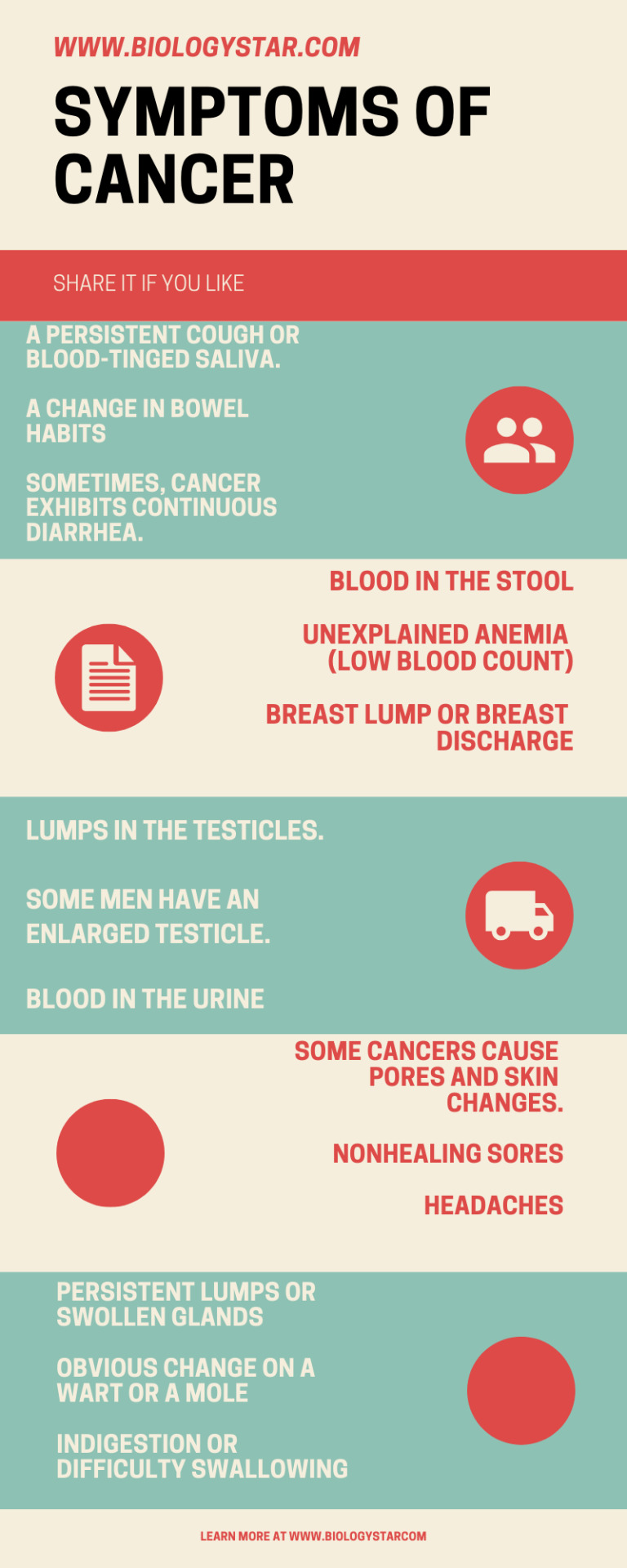
SYMPTOMS
Complications
Cancer and its treatment could cause several complications, including: Pain. Pain can be due to cancer or by tumor treatment, though not absolutely all cancer is painful. Prescription drugs and other approaches can properly treat cancer-related pain. Fatigue. Fatigue in people with cancer has many causes, but it can frequently be managed. Difficulty breathing. Cancer or cancers treatment may cause a feeling to be short of breath. Procedures may bring relief. Nausea. Certain cancers and cancers treatments could cause nausea. Your doctor will often predict if your treatment will probably cause nausea. Medications and different treatments may help you prevent or lower nausea. Diarrhea or constipation. Tumor and cancer treatment make a difference your bowels and reason diarrhea or constipation. Weight loss. Cancer and tumor treatment could cause weight loss. Tumor steals food from common cells and deprives them of nutrition. This is often not affected by just how many calorie consumptions or what kind of foodstuff is eaten; it's complicated to treat. Generally, using artificial diet through tubes into the stomach or vein does not help change the weight damage. Chemical changes within you. Cancer can upset the standard chemical balance within your body and raise your threat of serious complications. Signs or symptoms of chemical substance imbalances might include high thirst, regular urination, constipation, and confusion. Brain and nervous system problems. Cancer can press on close by nerves and distress and damage of function of one part of your body. Cancer that involves the mind could cause headaches and stroke-like signs and symptoms, such as weakness on one side of your body. Unusual disease fighting capability reactions to cancer. In some instances, the body's disease-fighting capability may react to the occurrence of cancer by attacking healthful cells. Known as a paraneoplastic syndrome, these very rare reactions can bring about a variety of signs or symptoms, such as for example difficulty walking and seizures. Cancer that spreads. As cancers advances, it could spread (metastasize) to other areas of your body. Where cancer spreads is determined by the type of cancer. Cancer that returns. Cancers survivors have a threat of cancer tumor recurrence. Some cancers will recur than others. Ask your physician in what you can do to reduce your risk of cancer recurrence. Your doctor may devise a follow-up care arrange for you after treatment. This course of action can include periodic scans and examinations in the months and years after your treatment, to look for cancer recurrence.
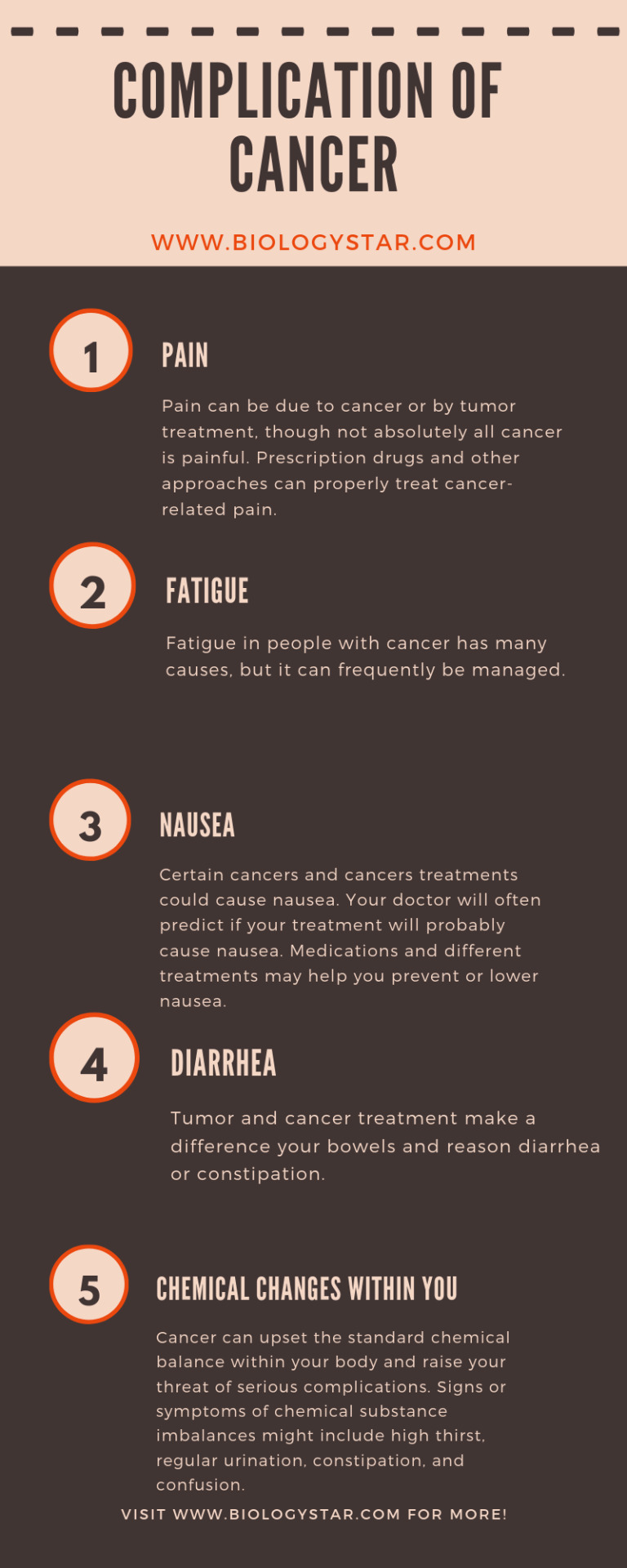
COMPLICATIONS
HISTORY
Cancer has existed for most of human history. The earliest written record regarding cancer is from circa 1600 BC in the Egyptian Edwin Smith Papyrus and describes breasts cancer. Hippocrates (ca. 460 BC - ca. 370 BC) described several varieties of cancer, referring to them with the Greek term karkinos (crab or crayfish). This name originates from the looks of the cut surface area of a good malignant tumor, with "the veins stretched on all sides as the pet the crab features its feet, whence it derives its brand". In the 15th, 16th and 17th centuries, it became acceptable for doctors to dissect bodies to find the reason for death. The German professor Wilhelm Fabry thought that breast cancer was the effect of a milk clot in a mammary duct. The Dutch professor Francois de la Boe Sylvius, a follower of Descartes, believed that disease was the results of chemical techniques and that acidic lymph fluid was the cause of cancer. His modern-day Nicolaes Tulp believed that cancers were a poison that gradually spreads and figured it was contagious. Hill described tobacco as the cause of cancer in 1761. This was followed by the report in 1775 by British surgeon Percivall Pott that chimney sweeps' carcinoma, cancer of the scrotum, was a common disease among chimney sweeps. With the widespread usage of the microscope in the 18th century, it was uncovered that the 'cancer poison' pass on from the primary tumor through the lymph nodes to other sites ("metastasis"). This viewpoint of the disease was first formulated by the English cosmetic surgeon Campbell De Morgan between 1871 and 1874.
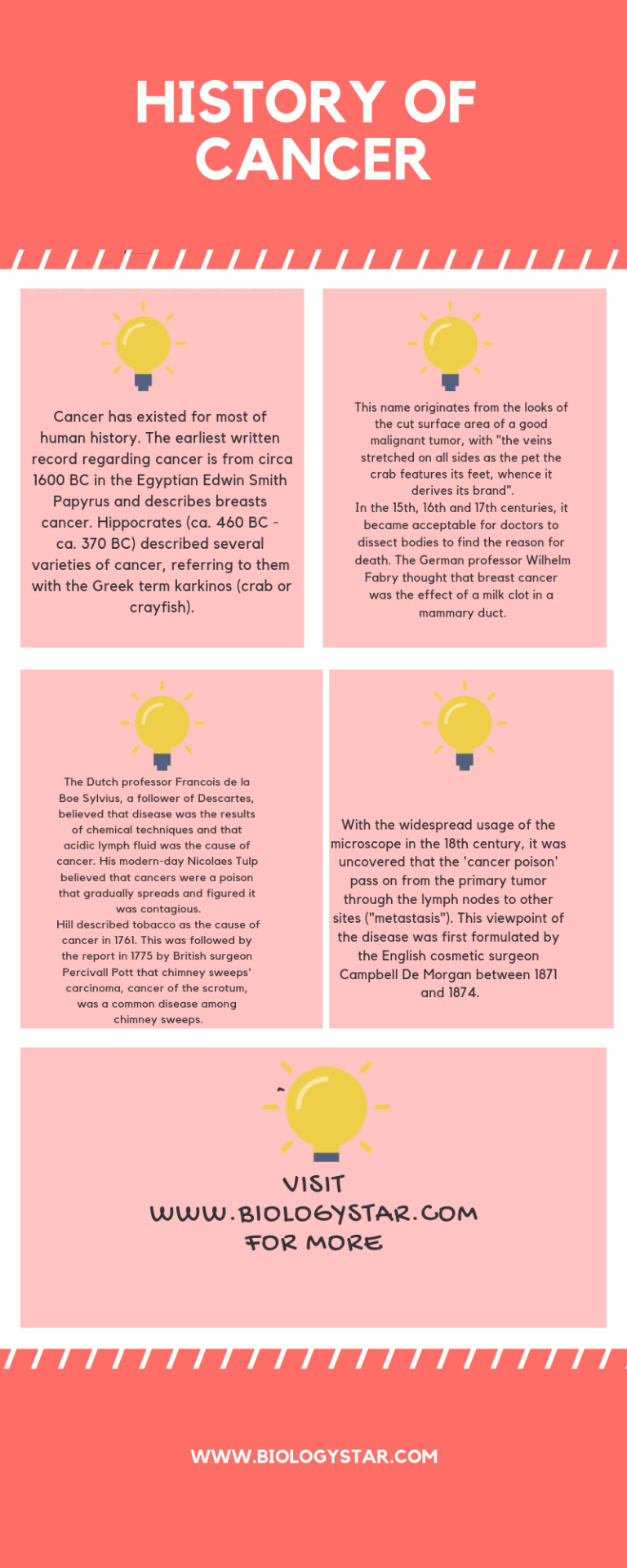
HISTORY
Prevention
There's no certain method to prevent cancer. But doctors have discovered several ways of reducing your cancer risk, such as for example: Stop smoking. If you smoke, quit. Unless you smoke, don't start. Smoking is normally linked to various kinds of cancer - not only lung cancer. Stopping today will reduce your risk of malignancy in the future. Avoid excessive sun exposure. Harmful ultraviolet (UV) rays from the sun can increase your threat of skin cancers. Limit your sun exposure by residing in the shade, using protective clothing or applying sunscreen. Eat a healthy diet. Select a diet rich in fruit and veggies. Select whole grains and lean proteins. Exercise most days of the week. Regular exercise is linked to less risk of cancer. In the event that you haven't been exercising on a regular basis, begin slowly and work the right path up to 30 minutes or longer. Maintain a healthy weight. Being overweight or obese may boost your risk of cancer. Function to achieve and maintain a wholesome weight through a combination of a healthy diet and regular exercise. Drink alcohol in moderation, in the event that you choose to drink. If you choose to consume alcohol, limit you to ultimately one drink a moment if you're a female of any age group or a man more than years 65, or two beverages a day if you're a man 65 years old or young. Schedule cancer screening exams. Speak to your doctor in what types of tumor screening exams are greatest for you based on your risk factors. Ask your physician about immunizations. Certain viruses boost your risk of tumor. Immunizations may help prevent those infections, including hepatitis B, which increases the threat of liver cancer, and individual papillomavirus (HPV), which escalates the threat of cervical cancer and various other cancers. Ask your physician whether immunization against these viruses is appropriate for you.
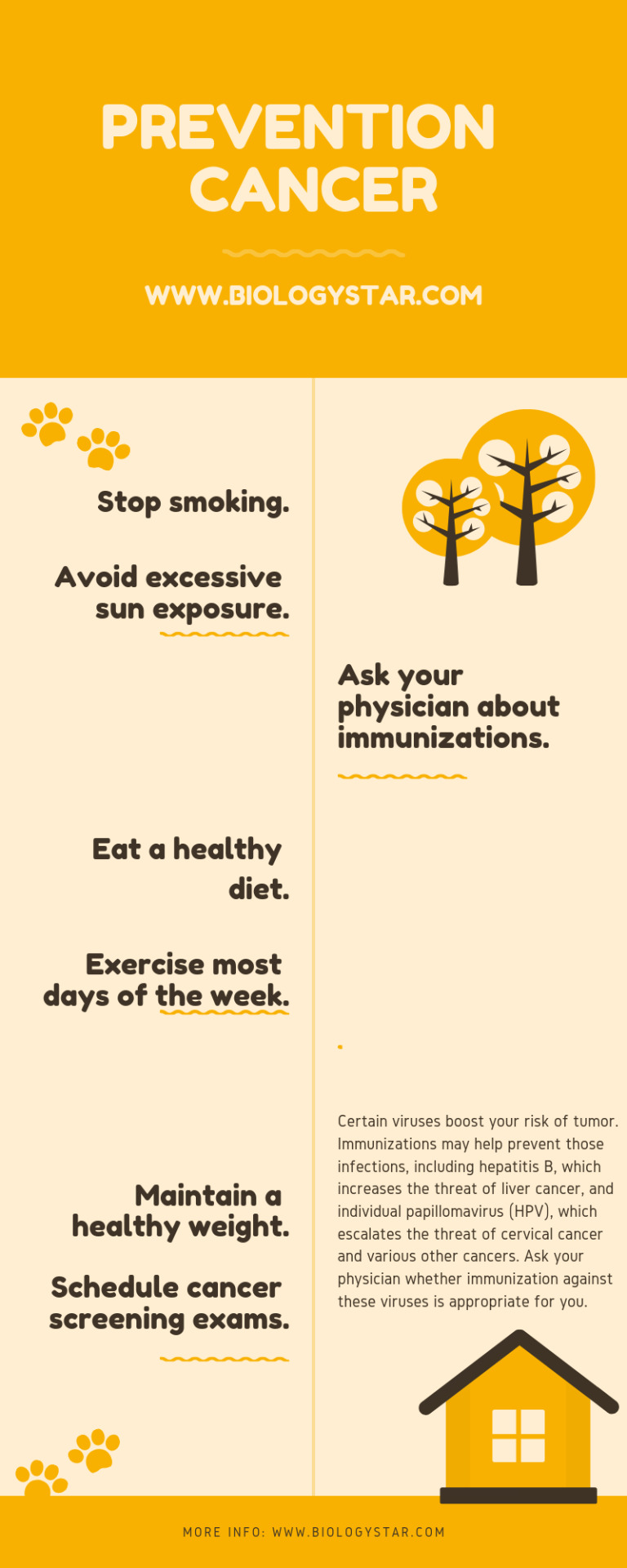
PREVENTTION
Screening
Unlike diagnostic efforts prompted by symptoms and medical signals, cancer screening involves efforts to detect cancer after it has formed, but before any noticeable symptoms appear. This might involve physical examination, bloodstream or urine testing or medical imaging. Cancer screening is not designed for many types of cancers. Even though tests are available, they might not exactly be recommended for everybody. General screening or mass screening includes screening everyone. Several factors are believed to determine whether the benefits of screening outweigh the hazards and the expenses of screening. These factors include: Likely harms from the screening test: for example, X-ray images involve contact with potentially harmful ionizing radiation The likelihood of the test effectively identifying cancer Possible harms from follow-up procedures Whether suitable treatment is available Whether early detection improves treatment outcomes If cancer will ever need treatment Whether the check is acceptable to the people: If a screening check is too burdensome (for example, extremely painful), then persons will refuse to participate. Cost.
TREATMENT
Many treatment options for cancer exist. The principal kinds include surgery, chemotherapy, radiation remedy, hormonal therapy, targeted therapy, and palliative care. Which therapies are used depends on the type, location, and quality of cancer plus the patient's health and tastes. The procedure intent may or may well not be curative.
Chemotherapy
Chemotherapy is the treatment of the tumor with a number of cytotoxic anti-neoplastic drugs (chemotherapeutic brokers) as part of a standardized regimen. The word encompasses a selection of drugs, which are split into broad categories such as alkylating brokers and antimetabolites. Traditional chemotherapeutic brokers act by eliminating cells that divide rapidly, a crucial property of all cancer cells. Targeted therapy is a sort of chemotherapy that targets particular molecular dissimilarities between cancer and common cells. Another common example is the school of Bcr-Abl inhibitors, which are being used to treat chronic myelogenous leukemia (CML). Presently, targeted therapies exist for most of the most common cancer types, including bladder cancers, breast cancer, colorectal tumor, kidney cancer, leukemia, liver cancer, lung cancer, lymphoma, pancreatic cancers, prostate cancer, skin cancers, and thyroid cancer along with other cancer types. The efficacy of chemotherapy depends upon the kind of cancer and the stage. In combination with surgery, chemotherapy has tested useful in cancers types including breast tumor, colorectal cancer, pancreatic cancers, osteogenic sarcoma, testicular cancer, ovarian cancer, and selected lung cancers. Chemotherapy is normally curative for some cancers, such as some leukemias, ineffective in a few human brain tumors, and needless in others, such as for example most non-melanoma epidermis cancers. The potency of chemotherapy is often limited by its toxicity to other cells within the body. Even when chemotherapy will not provide a permanent remedy, it may be beneficial to reduce symptoms such as for example pain or to reduce the size of an inoperable tumor in the desire that surgery can be possible in the future.
Radiation therapy
Radiation therapy involves the utilization of ionizing radiation so that they can either cure or perhaps improve symptoms. It functions by damaging the DNA of cancerous tissue, killing it. To spare common tissues (such as skin or organs, which radiation must go through to treat the tumor), designed radiation beams happen to be aimed from multiple publicity angles to intersect at the tumor, providing a much larger dose there than in the encompassing, healthy tissue. As with chemotherapy, cancers vary within their response to radiation therapy. The radiation could be either from internal resources (brachytherapy) or external sources. Rays is most commonly low strength x-rays for treating epidermis cancers, while higher strength x-rays are used for cancers in the body. Radiation is commonly used in addition to medical procedures and or chemotherapy. For several types of cancer, such as early head and neck malignancy, it might be used alone. For unpleasant bone metastasis, it's been found to work in about 70% of patients.
Surgery
Surgery is the primary approach to treatment for most isolated, solid cancers and could play a role found in palliation and prolongation of survival. It really is typically a crucial part of definitive medical diagnosis and staging of tumors, as biopsies usually are required. In localized cancer, medical procedures typically attempt to remove the complete mass along with, in certain situations, the lymph nodes in the region. For some types of cancer, this is sufficient to remove cancer.
Palliative care
Palliative care identifies the treatment that attempts to greatly help the patient look and feel better and could be combined with an effort to treat cancer. Palliative attention includes action to reduce physical, mental, spiritual and psycho-public distress. Unlike treatment that's aimed at directly killing cancers cells, the principal goal of palliative attention is to boost the quality of life. People at all levels of cancer tumor treatment typically receive some sort of palliative care. Occasionally, medical specialty professional organizations advise that patients and physicians react to cancer only with palliative care. This applies to patients who: display low-performance position, implying limited ability to care for themselves received no reap the benefits of prior evidence-based treatments are not eligible to take part in any appropriate clinical trial no strong evidence means that treatment would be effective Palliative care could be confused with hospice and therefore only indicated when persons approach the end of life. Like hospice attention, palliative care attempts to greatly help the individual cope with their immediate necessities and to increase relaxation. Unlike hospice care, palliative care does not require people to avoid treatment targeted at cancer. Multiple countrywide medical guidelines recommend early on palliative care for patients whose cancer has produced distressing symptoms or who must help to cope with their illness. In people first diagnosed with metastatic disease, palliative care could be immediately indicated. Palliative attention is indicated for patients with a prognosis of significantly less than 12 months of life even given aggressive treatment.
Immunotherapy
Various therapies using immunotherapy, stimulating or helping the disease fighting capability to fight cancer, have come into use since 1997. Methods include antibodies, checkpoint remedy, and adoptive cell transfer.
Laser therapy
Laser remedy uses high-intensity light to take care of cancer by shrinking or perhaps destroying tumors or precancerous growths. Lasers are mostly used to treat superficial cancers that happen to be on the top of the body or the liner of internal organs. It is used to take care of basal cell skin malignancy and the very first stages of others like cervical, penile, vaginal, vulvar, and non-tiny cell lung cancers. It can often be combined with other treatment options, such as surgery, chemotherapy, or radiation remedy. Laser-induced interstitial thermotherapy (LITT), or interstitial laser photocoagulation, uses lasers to take care of some cancers employing hyperthermia, which uses heating to shrink tumors by damaging or killing tumor cells. A laser is more specific than surgery and causes less destruction, soreness, bleeding, swelling, and scarring. A disadvantage is surgeons will need to have specialized training. It might be more expensive than other treatments.
Alternative medicine
Complementary and alternative cancer treatments are a diverse band of therapies, practices, and products that are not part of conventional medicine."Complementary medicine" identifies methods and chemicals used along with conventional medicine, while "alternative medicine" identifies compounds used instead of conventional medicine. Just about all complementary and alternative medications for cancer have certainly not been studied or tested using conventional techniques such as clinical trials. Some alternative procedures have been investigated and shown to be ineffective but nonetheless continue being marketed and promoted.
Economic effect
The total healthcare expenditure on cancer in the US was estimated to be $80.2 billion in 2015. Even though cancer-related healthcare expenditure has increased incomplete conditions during recent decades, the share of health expenditure specialized in cancer treatment has remained close to 5% between your 1960s and 2004. A similar pattern has been seen in Europe where about 6% of most healthcare expenditure is allocated to cancer treatment. Furthermore to healthcare expenditure, the tumor causes indirect costs with regards to productivity losses because of lost work times and premature death, and also informal treatment. Indirect costs are typically estimated to exceed the medical care costs of cancer.
Pregnancy
Cancer influences approximately 1 in 1,000 pregnant women. The most frequent cancers found during pregnancy will be the same as the most frequent cancers within non-pregnant women during childbearing age groups: breast cancer, cervical malignancy, leukemia, lymphoma, melanoma, ovarian cancers, and colorectal cancer. Diagnosing fresh cancer in a pregnant female is difficult, partly because any symptoms are generally assumed to become a normal discomfort connected with pregnancy. Because of this, cancer is typically learned at a somewhat later level than average. Some imaging techniques, such as for example MRIs (magnetic resonance imaging), CT scans, ultrasounds and mammograms with fetal shielding are believed safe during pregnancy; some others, such as PET scans, are not. Treatment is generally exactly like for non-pregnant women. On the other hand, radiation and radioactive medicines are normally avoided during pregnancy, particularly if the fetal dosage might go beyond 100 cGy. In some instances, some or all treatments happen to be postponed until after birth if the tumor is certainly diagnosed late in the pregnancy. Early deliveries can be used to advance the beginning of treatment. Surgery is normally safe, but pelvic surgeries through the first trimester could cause miscarriage. Some treatments, especially certain chemotherapy drugs given during the first trimester, raise the risk of birth defects and pregnancy damage (spontaneous abortions and stillbirths). Elective abortions are not needed and, for the most frequent forms and stages of the tumor, do not enhance the mother's survival. In a few occasions, such as advanced uterine malignancy, the pregnancy cannot be continuing and in others, the patient may end the pregnancy to ensure that she can get started aggressive chemotherapy. Some treatments can interfere with the mother's capability to give birth vaginally or to breastfeed. Cervical cancer may necessitate birth by Caesarean section. Radiation to the breasts reduces the ability of that breast to produce milk and increases the threat of mastitis. Likewise, when chemotherapy is provided after birth, many of the drugs come in breast milk, that could harm the baby.
List of cancer types
Chondrosarcoma Ewing's sarcoma Malignant fibrous histiocytoma of bone/osteosarcoma Osteosarcoma Rhabdomyosarcoma Heart cancer Breast cancer Invasive lobular carcinoma Tubular carcinoma Invasive cribriform carcinoma Medullary carcinoma Male breast cancer Phyllodes tumor Inflammatory Breast Cancer Adrenocortical carcinoma Islet cell carcinoma (endocrine pancreas) Multiple endocrine neoplasia syndrome Parathyroid cancer Pheochromocytoma Thyroid cancer Merkel cell carcinoma Astrocytoma Brainstem glioma Pilocytic astrocytoma Ependymoma Primitive neuroectodermal tumor Cerebellar astrocytoma Cerebral astrocytoma Glioma Medulloblastoma Neuroblastoma Oligodendroglioma Pineal astrocytoma Pituitary adenoma Visual pathway and hypothalamic glioma Uveal melanoma Retinoblastoma Anal cancer Appendix cancer cholangiocarcinoma Carcinoid tumor, gastrointestinal Colon cancer Extrahepatic bile duct cancer Gallbladder cancer Gastric (stomach) cancer Gastrointestinal carcinoid tumor Gastrointestinal stromal tumor (GIST) Hepatocellular cancer Pancreatic cancer, islet cell Rectal cancer Bladder cancer Cervical cancer Endometrial cancer Extragonadal germ cell tumor Ovarian cancer Ovarian epithelial cancer (surface area epithelial-stromal tumor) Ovarian germ cell tumor Penile cancer Renal cell carcinoma Renal pelvis and ureter, transitional cell cancer Prostate cancer Testicular cancer Gestational trophoblastic tumor Ureter and renal pelvis, transitional cell cancer Urethral cancer Uterine sarcoma Vaginal cancer Vulvar cancer Wilms tumor Esophageal cancer Head and neck cancer Nasopharyngeal carcinoma Oral cancer Oropharyngeal cancer Paranasal sinus and nasal cavity cancer Pharyngeal cancer Salivary gland cancer Hypopharyngeal cancer Acute biphenotypic Multiple myeloma/plasma cell neoplasm Myelodysplastic Syndromes Primary effusion lymphoma Plasmablastic lymphoma Sézary syndrome Splenic marginal zone lymphoma T-cell prolymphocytic leukemia Bronchial adenomas/carcinoids Small cell lung cancer Mesothelioma Non-small cell lung cancer Pleuropulmonary blastoma Laryngeal cancer Thymoma and thymic carcinoma Basal-cell carcinoma Melanoma Skin cancer (non-melanoma)
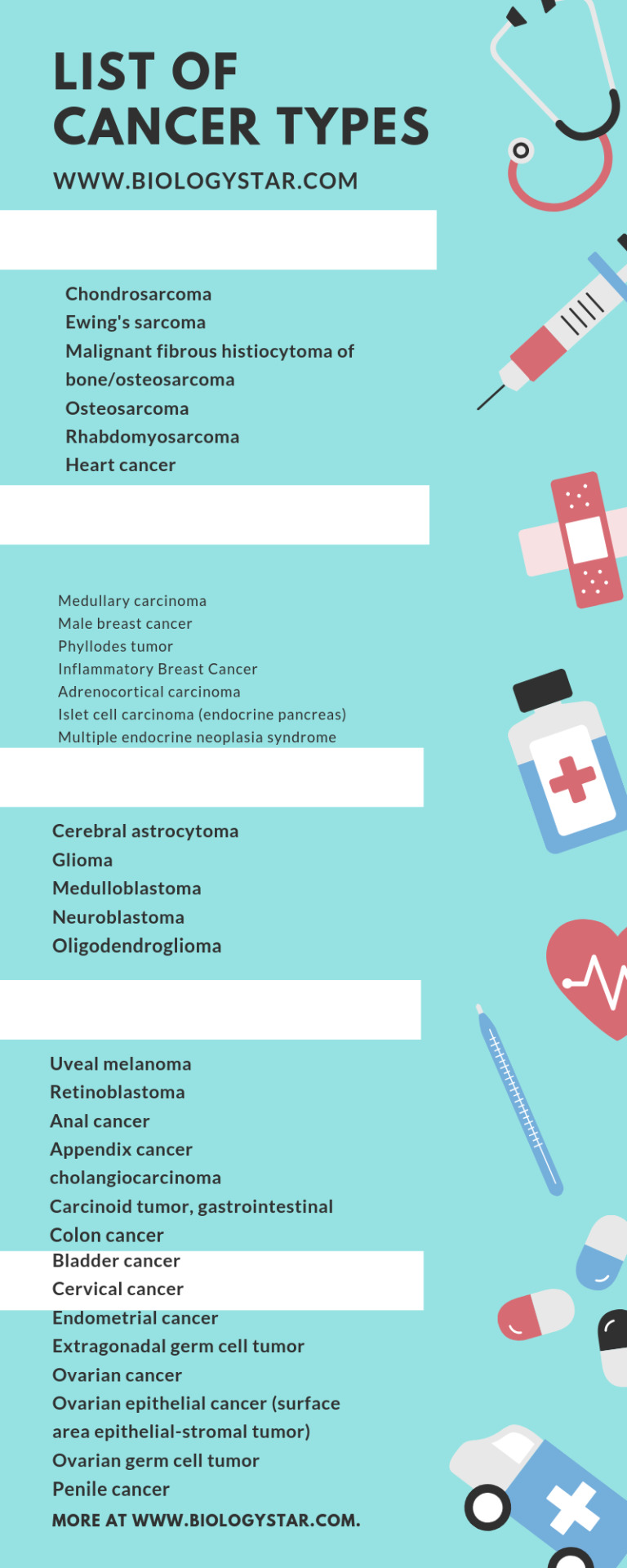
LIST
A short overview of some cancers
Chondrosarcoma
Chondrosarcoma is cancer made up of cells derived from transformed cells that manufacture cartilage. Chondrosarcoma is a member of a group of tumors of bone and very soft tissue referred to as sarcomas. About 30% of skeletal system cancers are chondrosarcomas. It really is tolerant to chemotherapy and radiotherapy. Unlike various other primary bone cancers that predominantly affect kids and adolescents, chondrosarcoma can present at any get older. It more often affects the axial skeleton compared to the appendicular skeleton.
Osteosarcoma
An osteosarcoma (OS) or perhaps osteogenic sarcoma (OGS) is a cancerous tumor in a good bone. Specifically, it really is an extreme malignant neoplasm that comes from primitive changed cells of mesenchymal origin (and therefore a sarcoma) and that exhibits osteoblastic differentiation and generates malignant osteoid. Osteosarcoma is the most typical histological kind of primary bone cancer. It is most prevalent in teenagers and adults.
Astrocytoma
Astrocytomas are a kind of cancer of the mind. They originate in a specific sort of glial cells, star-shaped mind cells in the cerebrum referred to as astrocytes. This kind of tumor will not usually spread outside the brain and spinal cord and it generally does not usually affect different organs. Astrocytomas happen to be the most frequent glioma and can occur in most parts of the mind and occasionally in the spinal cord. Within the astrocytomas, two wide classes are accepted in literature, people that have: Narrow zones of infiltration (mostly noninvasive tumors; e.g., pilocytic astrocytoma, subependymal huge cell astrocytoma, pleomorphic xanthoastrocytoma), that often are evidently outlined on diagnostic images. Diffuse zones of infiltration (e.g., high-quality astrocytoma, anaplastic astrocytoma, glioblastoma), that share various features, including the ability to arise at any location in the central nervous program, but with a preference for the cerebral hemispheres; they take place usually in adults, and also have an intrinsic tendency to advance to more advanced grades. People can form astrocytomas at any years. The low-grade type is more regularly found in children or young adults, while the high-grade type is more frequent in individuals. Astrocytomas in the bottom of the mind are more prevalent in young people and account for approximately 75% of neuroepithelial tumors.
Pituitary adenoma
Pituitary adenomas are actually tumors that occur on the pituitary gland. Pituitary adenomas are usually divided into three categories dependent after their biological operating: benign adenoma, invasive adenoma, and carcinomas. Just about all adenomas are benign, approximately 35% are invasive and just 0.1% to 0.2% are carcinomas. Pituitary adenomas represent from 10% to 25% of most intracranial neoplasms and the approximated prevalence rate in the overall population is approximately 17%. Non-invasive and non-secreting pituitary adenomas are considered to be benign in the literal in addition to the clinical sense; however a recently available meta-analysis (Fernández-Balsells, et al. 2011) of available research has displayed there are to time scant studies - of low quality - to either support or refute this assumption. Adenomas which exceed 10 millimeters (0.39 in) in proportions are thought as macroadenomas, with those small than 10 mm known as microadenomas. Many pituitary adenomas will be microadenomas and have around the prevalence of 16.7% (14.4% in autopsy analyses and 22.5% in radiologic research). Most pituitary microadenomas generally remain undiagnosed and the ones that are diagnosed are often found as an incidental selecting, and so are referred to as incidentalomas. Pituitary macroadenomas are actually the most common cause of hypopituitarism, and in nearly all cases they are actually non-secreting adenomas. While pituitary adenomas are common, affecting approximately one in 6 of the general population, clinically dynamic pituitary adenomas that require medical procedures are more rare, affecting approximately one in 1000 of the general population.
Medullary carcinoma
Medullary carcinoma may make reference to one of several numerous tumors of epithelial origin. As the word "medulla" is normally a generic anatomic descriptor for the mid-layer of various organ cells, a medullary tumor usually arises from the "mid-layer cells" of the relevant organ. Medullary carcinoma most commonly refers to: Medullary thyroid cancer Medullary carcinoma of the breasts.
Thyroid cancer
Thyroid cancer is cancer that develops from the cells of the thyroid gland. This is a disease where cells grow abnormally and also have the potential to pass on to other parts of the body. Symptoms range from swelling or a lump in the throat. Cancer can also happen in the thyroid after pass on from other spots, in which case it isn't classified as thyroid cancer. Risk factors include radiation publicity at an age, having a great enlarged thyroid, and genealogy. There are four key types - papillary thyroid tumor, follicular thyroid cancers, medullary thyroid tumor, and anaplastic thyroid cancer. Diagnosis is often predicated on ultrasound and excellent needle aspiration. Screening persons without symptoms and at common risk for the condition is not recommended by 2017. Treatment options can include surgery, radiation therapy including radioactive iodine, chemotherapy, thyroid hormone, targeted therapy, and watchful waiting around. Surgery may involve removing portion or all the thyroid. Five calendar year survival rates are 98% in the USA. Globally as of 2015 3.2 million persons have thyroid cancer. In 2012, 298,000 new instances occurred. Women are damaged more often than men. Those of Asian descent happens to be more commonly affected. Rates have increased in the last few years which is thought to be due to better detection. In 2015 it led to 31,900 deaths.
Merkel-cell carcinoma
Merkel-cell carcinoma (MCC) is usually a good rare and highly aggressive epidermis cancer, which, in most cases, is due to the Merkel cell polyomavirus (MCPyV or MCV) discovered by scientists at the University of Pittsburgh found in 2008. It is also referred to as cutaneous APUDoma, primary neuroendocrine carcinoma of your skin, primary little cell carcinoma of your skin, and trabecular carcinoma of the skin. About 80% of Merkel-cell carcinomas are due to MCV. The virus is usually clonally built-into the cancerous Merkel cells. Furthermore, the virus includes a particular mutation only when within cancer cells, but not when it is detected in healthy epidermis cells. Direct evidence because of this oncogenetic mechanism comes from the analysis showing that inhibition of production of MCV proteins causes MCV-contaminated Merkel carcinoma cells to die but has no influence on malignant Merkel cells that aren't contaminated with this virus. MCV-uninfected tumors, which take into account about 20% of Merkel-cell carcinomas, may actually have another and as-yet-unknown cause. Those generally have extremely large genome mutation rates, due to ultraviolet light exposure, whereas MCV-infected Merkel cell carcinomas have low prices of genome mutation.
Uveal melanoma
Uveal melanoma is cancer (melanoma) of the eye relating to the iris, ciliary body, or choroid (collectively referred to as the uvea). These melanocytes are distinct from the retinal pigment epithelium cells underlying the retina that usually do not contact form melanomas. When eyes melanoma is spread to distant areas of the body, the 5-year survival charge is about 15%.
Retinoblastoma
Retinoblastoma (Rb) is a good rare form of malignancy that rapidly develops from the immature cells of a good retina, the light-detecting cells of the attention. It is the most frequent primary malignant intraocular tumor in children, in fact, it is almost solely found in young children. Though virtually all children survive this cancer, they could lose their vision in the damaged eye(s) or have to have the eye removed. Practically half of the children with retinoblastoma contain a hereditary genetic defect connected with retinoblastoma. In other conditions, it is the effect of a congenital mutation in the chromosome 13 gene 13q14 (retinoblastoma protein).
Anal cancer
Anal cancer is definitely cancer (malignant tumor) which comes from the anus, the distal starting of the gastrointestinal tract. This is a distinctive entity from the more prevalent colorectal cancer. Anal cancer is normally an anal squamous cell carcinoma that arises close to the squamocolumnar junction, often associated with human papillomavirus (HPV) infection. It could be keratinizing (basaloid) or non-keratinizing (cloacogenic). Other styles of anal cancer happen to be adenocarcinoma, lymphoma, sarcoma or melanoma. From data collected 2004-2010, the relative five season survival rate in America is definitely 65.5%, though individual rates may vary depending upon the level of cancer at diagnosis and the response to treatment.
Appendix cancer
Appendix cancer or perhaps appendiceal cancers are actually rare malignancies of the vermiform appendix. Gastrointestinal stromal tumors are unusual tumors with malignant potential. Main lymphomas may appear in the appendix. Breast tumor, cancer of the colon, and tumors of the feminine genital tract may metastasize to the appendix.
Cholangiocarcinoma
Cholangiocarcinoma also called bile duct cancer, is definitely a sort of cancer that is composed of mutated epithelial cells (or cells showing attributes of epithelial differentiation) that originate found in the bile ducts which drain bile from the liver into the small intestine. Different biliary tract cancers involve gallbladder cancer and cancer tumor of the ampulla of Vater. Cholangiocarcinoma is a relatively rare neoplasm that's classified as an adenocarcinoma (cancer that forms glands or perhaps secretes quite a lot of mucins). It possesses a gross annual incidence rate of 1-2 cases per 100,000 in the Western world, but rates of cholangiocarcinoma have been rising worldwide in the last few decades. Prominent signs and symptoms of cholangiocarcinoma include abnormal liver function tests, belly pain, jaundice, and weight damage. Other symptoms such as for example generalized itching, fever, and changes in the color of stool or urine could also occur. The disease is diagnosed through a combination of blood checks, imaging, endoscopy, and sometimes medical exploration, with confirmation received after a pathologist examines cells from the tumor under a microscope. Known risk elements for cholangiocarcinoma include primary sclerosing cholangitis (an inflammatory disease of the bile ducts), contamination with the parasitic liver flukes Opisthorchis viverrini or Clonorchis sinensis, some congenital liver malformations, and exposure to Thorotrast (thorium dioxide), a chemical formerly found in medical imaging. However, most people with cholangiocarcinoma haven't any identifiable risk factors. Cholangiocarcinoma is known to be a great incurable and rapidly lethal cancers unless both the major tumor and any metastases can be fully removed by medical procedures. No possibly curative treatment exists except medical procedures, but many people have the advanced level disease at presentation and are inoperable during diagnosis. Persons with cholangiocarcinoma are usually managed - though not cured - with chemotherapy, radiation remedy, and other palliative care measures. They are also used as additional therapies after surgery in cases where resection has apparently been successful (or nearly so).
Read the full article
0 notes
Text
RECTAL CANCER- Ayurvedic Treatment, Diet, Exercises, Research Papers, Yoga & Pranayama
RECTAL CANCER- Ayurvedic Treatment, Diet, Exercises, Research Papers, Yoga & Pranayama
Rectal cancer is the carcinoma of the rectum (lower part of the large intestine). Cancer is a disease in which abnormal and uncontrolled cell division occurs and destroy healthy body tissues. SIGNS AND SYMPTOMS OF RECTAL CANCERCAUSES OF RECTAL CANCERPATHOPHYSIOLOGY OF RECTAL CANCERDIAGNOSIS OF RECTAL CANCERTREATMENTS FOR RECTAL CANCERPROGNOSIS OF RECTAL CANCERCOMPLICATIONS OF RECTAL CANCERRECTAL…

View On WordPress
0 notes